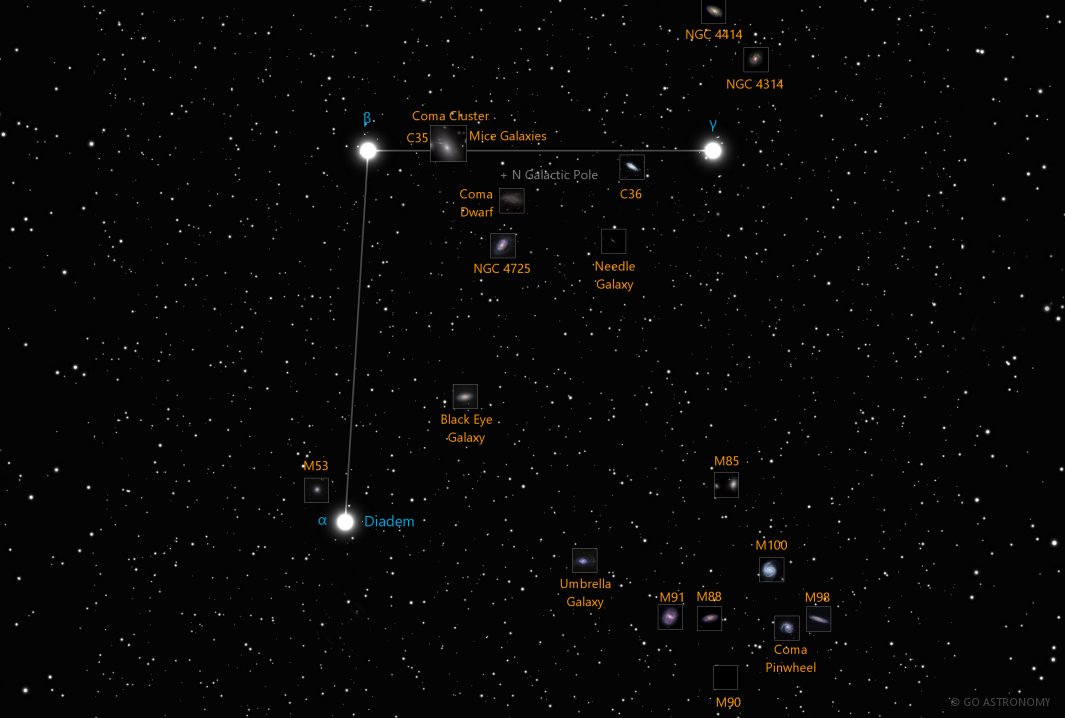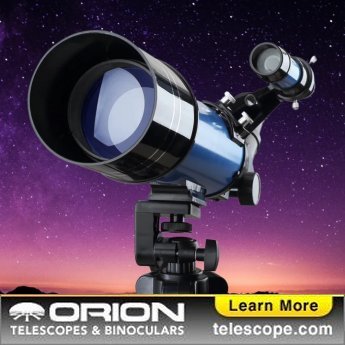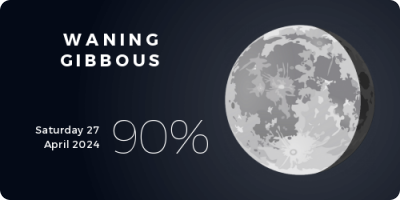Coma Berenices, the Berenice's Hair (Com)
(CO-muh BER-uh-NICE-eez)
The Northern constellation of Coma Berenices, the Berenice's Hair, is best viewed in Spring during the month of May.
Coma Berenices is the 42nd largest constellation. It's brightest star is Beta Comae Berenices at magnitude 4.26. The boundary of the Coma Berenices constellation contains 7 stars that host known exoplanets.
- Pronunciation:
- CO-muh BER-uh-NICE-eez
- Meaning:
- Berenice's Hair
- Genitive:
- Comae Berenices
- Abbreviation:
- Com
- Constellation Family:
- Ursa Major
- Hemisphere:
- Northern
- Quadrant:
- NQ3
- Visibility:
- 90° N - 70° S
- Best viewing month*:
- May
- Area:
- 386 sq. degrees
- Size:
- 42nd largest
- Right Ascension (avg):
- 12h 45m
- Declination (avg):
- 23°
- Brightest star:
- Beta Comae Berenices (4.26)
- Stars with planets:
- 7
Brightest Stars in Coma Berenices
The 10 brightest stars in the constellation Coma Berenices by magnitude.
- Star
- Magnitude
- Spectral class
- Beta Comae Berenices (β Com)
- 4.26
- G0V
- Alpha Comae Berenices (α Com)
- 4.32
- F5V
- Gamma Comae Berenices (γ Com)
- 4.35
- K2IIICN+
- 11 Comae Berenices (11 Com)
- 4.72
- G8III
- 36 Comae Berenices (36 Com)
- 4.76
- M0III
- 12 Comae Berenices (12 Com)
- 4.78
- F8:p
- 23 Comae Berenices (23 Com)
- 4.8
- A0IV
- 41 Comae Berenices (41 Com)
- 4.8
- K5III
- 35 Comae Berenices (35 Com)
- 4.89
- G8III
- 37 Comae Berenices (37 Com)
- 4.9
- K1IIIp
Double Stars in Coma Berenices
These are the brightest and easiest-to-find double, triple, and quadruple star systems in the constellation Coma Berenices . Also see all star clusters.
- Star system
- Magnitudes
- Type
- 24 Comae Berenices
- 5.1, 6.3
- double
Star Clusters in Coma Berenices
The most notable and easy-to-find star clusters in the constellation Coma Berenices . Also see all star clusters.
- Star cluster
- Catalog #
- Cluster type
- Coma Cluster
- open
- Messier 53
- M53
- globular
- NGC 4147
- globular
- NGC 5053
- globular
Galaxies in Coma Berenices
The most notable galaxies in the constellation Coma Berenices. Also see all galaxies.
- Name
- Alt name
- Type
- Black Eye Galaxy
- M64
- spiral
- Coma Pinwheel Galaxy
- M99
- spiral
- Malin 1
- spiral
- Mice Galaxies
- galaxy pair
- Needle Galaxy
- C38
- spiral
- Caldwell 35
- C35
- elliptical
- Caldwell 36
- C36
- spiral
- Messier 85
- M85
- lenticular
- Messier 88
- M88
- spiral
- Messier 91
- M91
- spiral
- Messier 98
- M98
- spiral
- Mirror Galaxy
- M100
- spiral
Milky Way Satellites in Coma Berenices
Dwarf satellite galaxies that orbit the Milky Way Galaxy located in the constellation Coma Berenices. Also see all Milky Way satellite galaxies.
- Galaxy name
- Alt name
- Magnitude
- Coma Berenices
Berenice's Hair
Coma Berenices, Latin for "Berenice's Hair," is a traditional constellation situated in the Northern Hemisphere's fourth quadrant (NQ4). The constellation is a relatively small one, but its unique features and historical significance make it a subject of interest for astronomers and enthusiasts alike.
Historical Overview
Coma Berenices owes its name to an intriguing tale of dedication and love from Ancient Egypt. As the story goes, Queen Berenice II of Egypt offered her long, beautiful hair to Aphrodite, the goddess of love, as a vow for her husband's safe return from war. After her hair mysteriously disappeared from the temple, the court astronomer proclaimed it had been immortalized in the night sky, thus forming the constellation.
Location and Notable Features
Coma Berenices is located near the larger and more prominent constellations of Leo and Virgo. Its precise coordinates are 13h 00m 00s, +20? 00' 00". It is bordered by constellations Canes Venatici, Leo, Virgo, and Bo?tes, making it visible at latitudes between +90? and -70?.
The constellation is comprised of several relatively faint stars, the brightest of which is Beta Comae Berenices, a Sun-like star that shines with an apparent magnitude of 4.26. Gamma Comae Berenices and Alpha Comae Berenices are other notable stars in this constellation, both being multiple star systems.
Deep Sky Objects
Coma Berenices is rich in deep-sky objects, primarily due to its location in the vicinity of the Virgo Cluster of galaxies. The constellation is home to the Coma Star Cluster (Melotte 111), a dense open star cluster nearly 288 light-years from Earth. The Coma Berenices galaxy cluster (Abell 1656), containing over a thousand galaxies, is one of the densest galaxy clusters known.
The Black Eye Galaxy (M64), characterized by a dark band of absorbing dust in front of the galaxy's bright nucleus, and the Needle Galaxy (NGC 4565), a stunning edge-on spiral galaxy, are also located in this constellation.
Observing Coma Berenices
Coma Berenices is best observed in the spring months in the northern hemisphere and autumn in the south. Its relatively faint stars require darker skies to be fully appreciated. However, the constellation's various deep-sky objects, particularly the galaxies, are of significant interest to astronomers.
The constellation's proximity to the constellation Leo also aids in its identification. Specifically, by drawing an imaginary line between the stars Denebola (Beta Leonis) and Vindemiatrix (Epsilon Virginis), one can locate the heart of Coma Berenices.
* Constellation shown for northen hemisphere skies. For the southern hemisphere, constellations appear rotated 180 degrees (upside-down and left-right reversed) from what is shown. Remember that seasons are reversed too - summer in northern latitudes is winter in southern latitudes.
** Circumpolar constellations are visible year-round in the hemisphere listed (and not at all in the opposite hemisphere).





